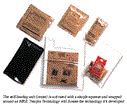Tempra signs deal to supply self-heating technology for U.S. Military MREs

Tempra Technology (Bradenton, FL), a developer of proprietary self-heating and self-cooling technologies, has entered into a collaborative licensing agreement with SOPAKCO to potentially replace the current heating unit included with military rations with Tempra's patented self-heating technology.
SOPAKCO is a leading provider of U.S. Military's MREs (Meals Ready to Eat), supplying them (formerly "K-Rations") since the 1940s. Tempra's self-heating technology, ideal for safe, fast, user-friendly heating of portable meals, will heat an MRE to approximately 140°F in about 10-12 minutes. The unit, which cooks the food in the MRE, is lightweight, completely self-contained and does not release any gases nor requires adding water.
"A soldier can still be on the move while heating his or her dinner," says Barney J. Guarino, president and CEO of Tempra Technology. "The technology currently used requires the soldier to take several preparatory steps, including adding water and keeping the unit stationary during the heating process."
The U.S. Military has long been challenged with how to supply troops with hot meals, safely, while in the field. The current method involves combining chemicals in a bag with a specific amount of water and keeping the unit stable for the 15 minutes it requires to heat the meal. Furthermore, vapors released by the existing heater contain hydrogen, a flammable gas.
The Tempra technology consists of a bubble of glycerin and a powdery potassium compound contained between two layers of film, creating a self-heating wrap equal in size to the MRE. The self-heating unit is included in the MRE kit along with the packaged meal. The user activates the heating unit by squeezing the bubble, which releases the glycerin that mixes with the powder to create the heat. The user then wraps the heating unit around the packaged meal and places the meal back in its MRE container. The meal can then be easily carried in a jacket pocket while it heats.

The heating unit can attain a range of temperatures. The heating process is time-delayed, giving the soldier ample opportunity to place the meal back in its package before it gets too hot to handle. By coating the particles in its heating units to dissolve at slower or faster paces, Tempra is able to regulate the temperature and the speed with which heat is achieved.
Tempra, whose patented self-heating technology can be applied to pouches, cups, trays and other packaging products, will produce the powder used in the heating element of the MRE. SOPAKCO is buying machinery from Tempra to package the material and make the heating element. The Mullins, SC, company is paying Tempra an upfront royalty payment, and Tempra will also receive a royalty on each MRE sale.
The new MRE heater will undergo field testing later this year. James DePhillips, Tempra's director of sales and marketing, says the product has already passed drop tests, and 600 units have been delivered to Texas to be put into MRE kits, which will then be sent to Alaska for the field testing by soldiers.
Tempra Technology is also applying its technology to heat consumer hand-held foods. According to Guarino, Tempra is looking at several commercial applications for its self-heating technology, including warming dips for chips, and self-contained soups, chilies, stews, coffee, hot cocoa and shelf-stable meals.
"We have developed a portable, completely non-toxic, safe way to heat food on-the-go. Box lunches don't have to be cold anymore," states Guarino. "This technology will take convenience meals and snack foods to places microwaves and stoves cannot go."
For more information: Tempra Technology, Tel: 800-867-9189, Website: www.tempratech.com
Edited by Bill Noone
